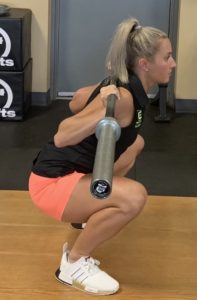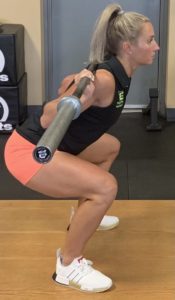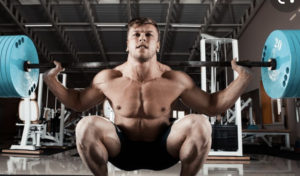Should you squat to full depth?
CORE Physical Therapy In Omaha Explains…
By Dr. Mark Rathjen PT DPT CSCS
CORE Physical Therapy Co-Owner
17660 Wright St. 9/10
Omaha, NE
402-933-4027


“The results suggest that full squat training is more effective for developing the lower limb muscles excluding the rectus femoris and hamstring muscles…”
“The volumes of adductor and gluteus maximus muscles significantly increased in FST (6.2 ± 2.6% and 6.7 ± 3.5%) and HST (2.7 ± 3.1% and 2.2 ± 2.6%). In addition, relative increases in adductor (p = 0.026) and gluteus maximus (p = 0.008) muscle volumes were significantly greater in FST than in HST.”

Furthermore, full depth training can be lower in load as dependent on the full range and subsequently less overall strain. The thing to keep in mind is the load may be lower, and as long as the subject has normal full hip, ankle trunk motion with squat mechanics then it should be safer.
Proper squat form screening and range of motion screening is vital to executer a full squat without deviations. It cannot be overlooked or underscored on the importance of such screening. In clinic, we often seen large issues with range and compensation patterns overall. This can lead to overuse and injured lumbar spine, and BLE knee pain, etc.
CORE Physical Therapy and Sports Performance specializes in the treatment of athletes. We understand the importance of proper strength training form and mechanics and the role it plays in sports. We have fully trained Doctors with advanced degrees and experience overall that can help you with form and programming. Our owners, Dr. Mark and Dr. Claire are current/former competitive powerlifters with over 35 years of experience in the field.
Come and see the CORE difference…
At CORE Physical Therapy in Omaha, We specialize in the treatment of athletes. We have worked with athletes for a combined 30 years. CORE was established in 2015 by Dr. Mark and Dr. Claire Rathjen is family owned and operated.
We are proud to serve the greater Omaha metro area.
For More information, Please feel free to contact us http://coreomaha.com/contact/
Please feel free to follow us at https://www.facebook.com/COREomaha/
To get started http://coreomaha.com/getting-started/
For more Blog information http://coreomaha.com/blog/
Youtube Account linked below.
https://www.youtube.com/channel/UCVg8OSN5h-i1n_ykw1Gvahg?view_as=subscriber
Effects of squat training with different depths on lower limb muscle volumes
- PMID: 31230110
- DOI: 10.1007/s00421-019-04181-y
Abstract
Purpose: The purpose of this study was to compare the effects of squat training with different depths on lower limb muscle volumes.
Methods: Seventeen males were randomly assigned to a full squat training group (FST, n = 8) or half squat training group (HST, n = 9). They completed 10 weeks (2 days per week) of squat training. The muscle volumes (by magnetic resonance imaging) of the knee extensor, hamstring, adductor, and gluteus maximus muscles and the one repetition maximum (1RM) of full and half squats were measured before and after training.
Results: The relative increase in 1RM of full squat was significantly greater in FST (31.8 ± 14.9%) than in HST (11.3 ± 8.6%) (p = 0.003), whereas there was no difference in the relative increase in 1RM of half squat between FST (24.2 ± 7.1%) and HST (32.0 ± 12.1%) (p = 0.132). The volumes of knee extensor muscles significantly increased by 4.9 ± 2.6% in FST (p < 0.001) and 4.6 ± 3.1% in HST (p = 0.003), whereas that of rectus femoris and hamstring muscles did not change in either group. The volumes of adductor and gluteus maximus muscles significantly increased in FST (6.2 ± 2.6% and 6.7 ± 3.5%) and HST (2.7 ± 3.1% and 2.2 ± 2.6%). In addition, relative increases in adductor (p = 0.026) and gluteus maximus (p = 0.008) muscle volumes were significantly greater in FST than in HST.
Conclusion: The results suggest that full squat training is more effective for developing the lower limb muscles excluding the rectus femoris and hamstring muscles.
Keywords: Adductor; Gluteus maximus; Hamstring; Knee extensor; Magnetic resonance imaging.
Similar articles
-
Muscle Activation Differs Between Partial and Full Back Squat Exercise With External Load Equated.
J Strength Cond Res. 2017 Jun;31(6):1688-1693. doi: 10.1519/JSC.0000000000001713.PMID: 28538321 Clinical Trial. -
J Strength Cond Res. 2018 Oct;32(10):2770-2775. doi: 10.1519/JSC.0000000000002513.PMID: 29465608
-
J Strength Cond Res. 2019 Jul;33 Suppl 1:S85-S94. doi: 10.1519/JSC.0000000000002617.PMID: 29870422
-
J Strength Cond Res. 2019 Oct;33(10):2595-2601. doi: 10.1519/JSC.0000000000003290.PMID: 31356511
-
Anatomy, Bony Pelvis and Lower Limb, Thigh Muscles.
2021 May 3. In: StatPearls [Internet]. Treasure Island (FL): StatPearls Publishing; 2021 Jan–.PMID: 29494052 Free Books & Documents. Review.
